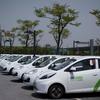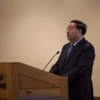政策
. 2018. “Power system capacity expansion under higher penetration of renewables considering flexibility constraints and low carbon policies.” IEEE Transactions on Power Systems, 33, 6, Pp. 6240-6253. Publisher's VersionAbstract
. 2018. “Carbon tax for achieving China's NDC: Simulations of some design features using a CGE model.” Climate Change Economics. Publisher's VersionAbstract
《金融时报》报道中国项目关于电动汽车充电方式对中国环境影响的最新研究
2018年春季学期新闻通讯
评论:全球电网是否是通向低碳未来之路?
推广电动车会对中国环境产生什么影响?车辆充电方式是关键!
中国国家电网公司前董事长刘振亚就全球能源互联网在哈佛大学发表公开演讲
2018
Apr
27
. 2018. “Environmental fiscal reform and the double dividend: evidence from a dynamic general equilibrium model.” Sustainability, 10, 2. Publisher's VersionAbstract
2018
Apr
25
2018
Apr
17
2018
Feb
12
2018
Jan
31
. 2019. “Transition from non-commercial to commercial energy in rural China: Insights from the accessibility and affordability.” Energy Policy, 127, Pp. 392-403. Publisher's VersionAbstract






